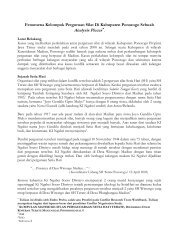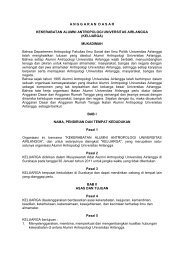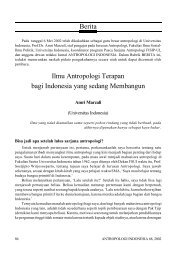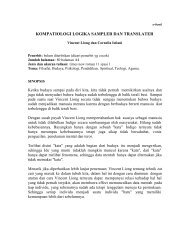The Future of Visual Anthropology: Engaging the Senses
The Future of Visual Anthropology: Engaging the Senses
The Future of Visual Anthropology: Engaging the Senses
You also want an ePaper? Increase the reach of your titles
YUMPU automatically turns print PDFs into web optimized ePapers that Google loves.
widijanto judono e-Library collection - widijanto.wordpress.com<br />
<strong>The</strong> more practical dimension to this context is that <strong>the</strong>re is a niche for visual<br />
anthropologists to work on applied projects, participating in <strong>the</strong> development <strong>of</strong><br />
<strong>the</strong>oretically informed ‘applied visual anthropology’. This may provide important<br />
directions for a future in which visual anthropology has a more prominent public<br />
pr<strong>of</strong>ile and engages with what some have argued is our responsibility to promote a<br />
public anthropology that comments on and intervenes in issues <strong>of</strong> public concern.<br />
It additionally creates employment possibilities for visual anthropologists in a<br />
context where tenured academic posts in anthropology departments seem increasingly<br />
scarce and employment possibilities for PhD anthropologists are limited.<br />
<strong>The</strong> new media context<br />
<strong>Engaging</strong> <strong>the</strong> visual 19<br />
<strong>Visual</strong> and digital technologies and media are becoming more economically accessible<br />
and ‘user-friendly’. Related to this, visual methodologies are more widely used<br />
by anthropologists and thus visual anthropology and <strong>the</strong> <strong>the</strong>oretical and empirical<br />
concerns <strong>of</strong> mainstream anthropology become more firmly wedded. <strong>Visual</strong> anthropologists<br />
have argued that <strong>the</strong> way forward would be both to integrate <strong>the</strong> visual<br />
into mainstream anthropology and to incorporate anthropological aims into<br />
ethnographic filmmaking. This would give <strong>the</strong> visual a critical role in revising <strong>the</strong><br />
categories through which anthropological knowledge is produced (Grimshaw<br />
2001: 173; MacDougall 1997: 292) by introducing <strong>the</strong> visual as an alternative way<br />
<strong>of</strong> understanding, and route to knowledge about, social phenomena. Moreover, a<br />
new agenda for digital ethnographic video-making has suggested <strong>the</strong> production <strong>of</strong><br />
films according to anthropological, ra<strong>the</strong>r than broadcast television, agendas<br />
(MacDougall 2001; Ruby 2001). <strong>The</strong> future <strong>of</strong> this relationship should be a twoway<br />
process through which mainstream anthropology comes to accommodate<br />
visual knowledge and ethnographic film comes to accommodate anthropological<br />
concerns. In this book I suggest that we need to create a visual anthropology that<br />
no longer simply defends itself against <strong>the</strong> mainstream, but that responds to developments<br />
in anthropological <strong>the</strong>ory that might <strong>the</strong>mselves shape visual anthropology<br />
in some ways. One way this is already achieved is by accommodating<br />
<strong>the</strong>oretical developments in anthropology within visual projects – for example, to<br />
make <strong>the</strong>oretically informed visual representations. Ano<strong>the</strong>r is to develop new<br />
forms <strong>of</strong> visual representation that can communicate <strong>the</strong>oretically, and thus will be<br />
conversant with <strong>the</strong>oretical debates in mainstream anthropology in ways that film<br />
is not. This might involve producing not only new forms <strong>of</strong> ethnographic film, but<br />
hypermedia texts that combine word and image. More broadly this involves examining<br />
<strong>the</strong> potential <strong>of</strong> a digital ethnography for <strong>the</strong> development <strong>of</strong> an anthropology<br />
that re-situates <strong>the</strong> visual and in doing so encourages innovative forms in anthropological<br />
fieldwork and representation.<br />
Moves to new media are increasingly represented in <strong>the</strong> practice <strong>of</strong> established<br />
visual anthropologists such as Peter Biella and Jay Ruby, postgraduate training in<br />
visual anthropology, 27 and international workshops. 28 In chapters 4 and 6 I propose<br />
that opportunities to work with new visual and digital media – especially digital










